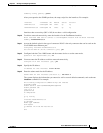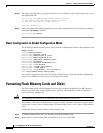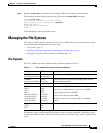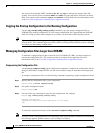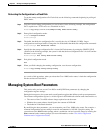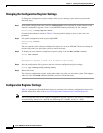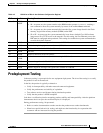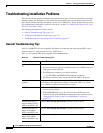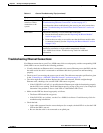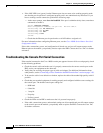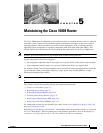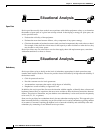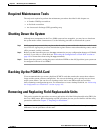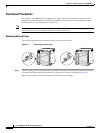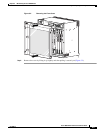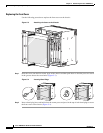
4-13
Cisco 10008 Router Hardware Installation Guide
OL-0659-13
Chapter 4 Starting and Configuring the Router
Troubleshooting Installation Problems
Troubleshooting Ethernet Connections
If an Ethernet connection to your Cisco 10008 router fails to work properly, and the corresponding LNK
(Link) LED is not on, check for the following problems:
• Visually check that an Ethernet cable is connected to the correct Ethernet port on the PRE, and that
the other end of the cable is connected to an Ethernet hub that is powered on and functioning
properly.
• Check to see if you are using the correct type of cable. The cable must meet the specifications given
in the “Connecting to a 10BASE-T Ethernet Network” section on page 3-32.
• The cable might be bad or broken. Replace the cable with a known, reliable straight-through
Ethernet cable, checking to be sure the LNK LED comes on (green).
–
If the LNK LED is still off, it is possible that the Ethernet port might be functioning properly,
but the LED is not working. Check the Ethernet port (by trying to ping over it, for example) to
determine if the problem is due to a bad LED or if the Ethernet link is bad.
• Make sure the PRE has booted up properly as follows:
–
The Status LED should be on (green).
–
If the Fail LED is on (yellow), see the Cisco 10000 Series Router Troubleshooting Guide for
troubleshooting information.
• Check the hub:
–
Is the cable connected into the correct hub port (for example, the hub LED is on, but the LNK
LED on the PRE is not on).
–
Be sure that the cable is not connected to an uplink port.
You cannot establish a
console or Telnet
connection to the
system.
For information about troubleshooting Ethernet connections, see the
“Troubleshooting Ethernet Connections” section on page 4-13.
For information about troubleshooting the console port serial connections,
see the “Troubleshooting the Console Port Serial Connection” section on
page 4-14.
Fan Failure Perform the following if a FAN FAILURE LED lights:
• Reseat the blower module (see the “Replacing the Blower Module”
section on page 5-10).
• Remove the rear safety cover and be sure that the blower module cable
is connected securely (see the “Replacing the Blower Module” section
on page 5-10).
System overheats This may be due to a failure in the blower module (see Fan Failure above),
insufficient ventilation, or high ambient temperature. See the
Cisco 10000 Series Router Troubleshooting Guide for additional
information.
Table 4-3 General Troubleshooting Tips (continued)
Symptom Steps to Take



